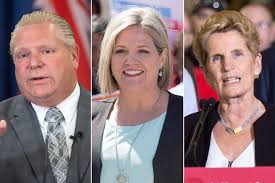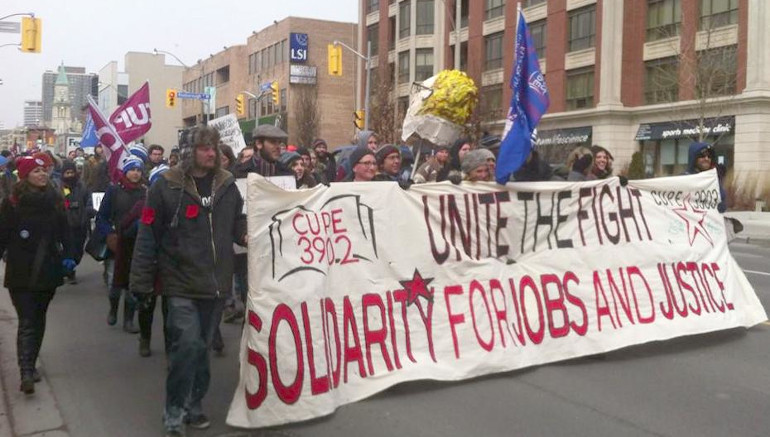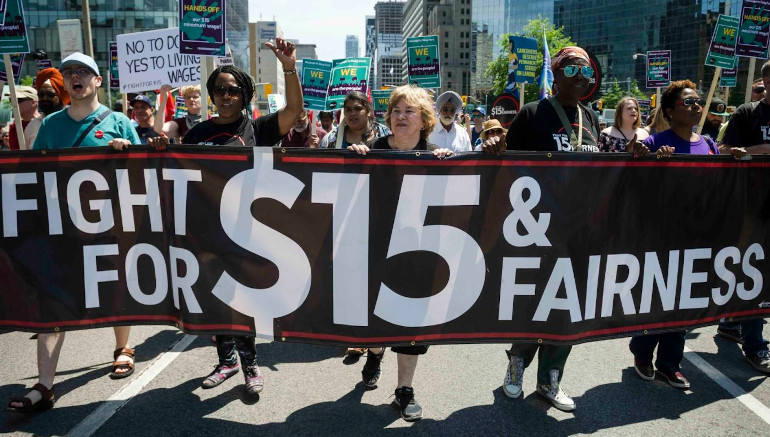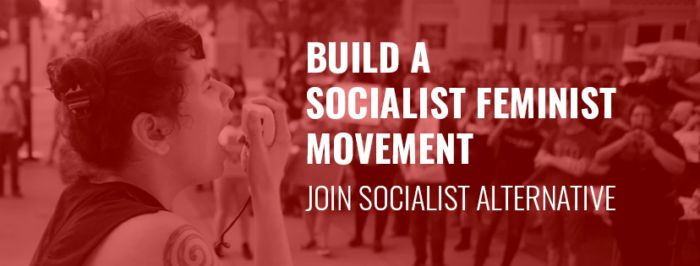Ontario’s June 7 election has heated up, not only because of the participation of Doug Ford, the so-called Canadian Donald Trump and apparent front runner, but because the outcome of the election itself is by no means certain. Since the New Year, Ontario politics have been anything but dull. At the start of 2018, it looked as if the unpopular Liberals, 15 years in power, were heading for a predictable defeat. They are remembered for corruption scandals, the privatization of Ontario Hydro and attacks on education workers’ bargaining rights. Even the desperate and opportunist attempts to revive their left credentials in the last few months, by announcing a $15 minimum wage, labour reforms and expanded programs like pharmacare, dental care and child care weren’t enough to produce a Lazarus like resurrection.
The obvious beneficiary seemed to be the Progressive Conservative Party that was actually giving the impression of having some genuine “progressive” policies, rather than just an oxymoronic label. Their leader, Patrick Brown, had effectively outmanoeuvred the influential social conservative tendency in the party’s base so that abortion, gay marriage, and a promise to get rid of the Liberals’ sex education curriculum would not be in the party program. He also took on the climate change sceptics in the party, convincing the majority of the need to live with the Liberals’ version of a carbon tax, the cap and trade policy.
But then came a tumultuous few weeks in January, when two young women came forward with charges of sexual misconduct against Brown. He was forced to resign, triggering a leadership election. Doug Ford stepped in, going on to win by a hair’s breadth. From then on, the polls indicated that the election was going to be a cakewalk for Ford and the PCs – they were up at around 42%, the Liberals at 26%, the New Democratic Party (NDP, Canada party with social democratic roots) at 22% and the Greens at 5%. Throughout March and April, this scenario looked likely to be born out with the standings staying much the same, the Tories dropping just a couple of insignificant points. But then drama returned in May with a dramatic turnaround in fortunes with the Liberals going into free fall (down to 21%) and the NDP (37%) overtaking the PCs (36%)
So what is going on?
Let’s first look at the Ford phenomenon. Doug Ford was not even a parliamentarian at the time of his ascension to the leadership in February. His political experience was as a Toronto City Councillor who had unsuccessfully run for Mayor in 2014. Rather it was his late, infamous, crack cocaine smoking brother Rob, Toronto Mayor from 2010 to 2014, who provided the launching pad for Doug to establish a profile that would eventually extend beyond Toronto and appeal to the right-wing base in other parts of Ontario. Both Rob and Doug were the faces of “Ford Nation”, originally a TV show, where the 2 words came to represent the right-wing populism espoused by the Fords.
Ford shares many of the features of right-wing populist movements in the US and other parts of the world:
- anti-elitism (but note Ford is a part of a family business that generates $100m in sales) for example, Ford wants to fire the “six million dollar man”, the CEO of publicly owned Ontario Hydro who is on a $6m salary
- an appeal to “the little guy”, eliminating government “waste”
- cutting taxes, and ending “the gravy train” (perks, expenses and trips of elected government officials)
- privatization of inefficient, “expensive” public services and playing up to the small and big business lobbies
Is Ford Canada’s Trump?
Yes and no. Both Ford and Trump espouse the elements of populism listed above. There are similarities in their style too – “telling it like it is”, anti-intellectualism and looseness with the facts. However, there are important differences. First, although Ford definitely appeals to the bigots, racism is not a card he plays, mainly because the Ford brothers early on developed their electoral base in the working class and immigrant areas of Toronto. Likewise, he has distanced himself from the Islamaphobic elements in his Party even if he was cynically prepared to use those elements to defeat his more “moderate” leadership challenger. Ford also dissociated himself from his more exuberant followers who, at one rally, chanted, Trump style, “Lock her (Premier Kathlyn Wynne) up.”
Toronto Star columnist Rick Salutin referred to the Ford phenomenon in this way.He had asked a young millennial about a survey showing that most young people were veering towards Ford. The millennial “wasn’t surprised. You people, he said, have no idea how angry people his age are. In their entire lives they’ve known nothing but disappointment. Vast student debt, Mideast wars, the crash of ’08. They’ll never own a house, have secure careers or live in a lively urban downtown. Many already believe a family is unreachable. Some will, or are, living with parents…..They’ve been screwed. And there you have it. The populist message is: You’ve been screwed, and I’m with ya. Doug Ford has the most stripped-down version of this in the world: ‘You know me. I’m for the little guy.’ Full stop. He doesn’t do racism, misogyny, blaming immigrants and Muslims, except inadvertently, and then he reverses. It’s populism made easy and it’s working.”
Well, it was working for a good part of the campaign, but then things changed.
The tide turns – Ford’s true colours revealed
In early March, the polls showed the PCs at 45%, the Liberals at 25% and the NDP at 24%. By the end of May, there was a dramatic change. The PCs had dropped to 35.7%, overtaken by the NDP at 36.2% and the Liberals collapsing even further to 20.7%. How to explain this shift?
At the beginning of the campaign, the focus for many voters was more on getting rid of Wynne and the Liberals, not so much on who would be the best replacement. As the campaign progressed questions began to be asked about Ford. His pot shots against the elite looked hollow when his proposed tax cuts for the middle class were shown to be benefiting the most wealthy. For somebody making between $39,000 and $49,000 a year, they would receive only $18 a year from the tax cut. While someone who is making more than $109,000 a year gets more than $1,168. For someone who was supposed to be looking out for the little guy, Ford’s position of opposing the minimum wage to $15 an hour also didn’t sit well. He suggested, incorrectly, that his tax cut would more than compensate for not increasing the minimum wage. The typical worker on minimum wage would be $712 better off with an increase in the minimum wage rather than with the tax cut.
There were other issues. Ford was caught on camera conducting backroom talks with real-estate developers to open up Toronto area’s protected green-belt (Ford called them “just farmers’ fields”) to a frenzy of housing construction. As the campaign progressed people became increasingly concerned about Ford’s tax give aways (estimated at $25 billion by some economists) with no explanation of how this could be done without, at the same time, slashing public services. His policy platform, described as “skeletal”, was only made public in the last week of the campaign.
All this contributed to many people starting to look for a way of dumping the Liberals but without bringing in Ford. The logical choice was Andrea Horwath and the NDP.

The fall and rise of the NDP
The NDP has been in power once in Ontario, the 1990-95 government of Bob Rae. While elected on a radical platform, Rae’s government faced with an economic recession quickly abandoned its policies moving to austerity. It was a disaster – tearing up of public sector workers’ contracts, imposing a wage freeze and forcing unpaid leave days. Rae also abandoned one of the NDP’s more popular promises, the public ownership of auto insurance. Rae’s unpopularity paved the way for the election in 1995 of the PCs with slash-and-burn Mike Harris at the helm.
Since then, the NDP, electorally, has been the third place party in Ontario. In the 2011 election, the NDP pledged to bring the province’s large-scale electrical generating capacity back in public hands. Horwath, elected NDP leader in 2009, said that the Liberal government’s gradual move to privatize power had pushed prices up.
In the 2014 election, the NDP, also under Horwath’s leadership, presented a pathetic challenge to the Liberals, offering what they considered to be a safe and non-radical alternative. In the 2014 platform there was no talk of public power. Gone, too, were other interventionist proposals from 2011. Plans to set gasoline prices were omitted and they ditched all references to freezing transit fares. While they had some good planks to their platform, such as freezing tuition fees and a small increase in corporation tax, their whole approach was insipid. The platform’s weakness provoked a group of 34 high-profile NDP supporters to take the unusual step of publicly threatening to break with the party. Horwath ignored them going out of her way to portray the NDP as market-oriented and business-friendly.
The 2014 platform said the NDP would intervene immediately to cut auto insurance rates by 15%. But it was silent on the one reform shown to reduce premiums permanently — public auto insurance, (no doubt Horwath didn’t want to be reminded about that proposal under Bob Rae in the ‘90s). In general, the NDP continued its unrequited love affair with small business. Horwath spent much of her time outside the urban areas, distancing herself from the NDP’s traditional labour connections and instead pandering to small business. She proposed cutting the small business tax, and providing wage subsidies to all businesses, large and small, that hired new workers.
When government pensions were a hot issue, the NDP dropped all talk of setting up an Ontario version of the Canada Pension Plan, a major plank in its 2011 campaign. This let Horwath avoid the embarrassment of explaining why she didn’t support the Liberal proposal to create such a pension plan. But it also put the NDP on side with small businesses anxious to avoid the extra payroll taxes that new, mandatory pension scheme would demand. Even big business was treated more gently in this election campaign. In 2011, the NDP proposed hiking corporate tax rates to 14%. In 2014, Horwath proposed raising the corporate tax rate to just 12.5%
As the NDP was moving right, the Liberals were moving left and they both ended up in a similar place with the Liberals slightly to the NDP’s left. As journalist, Thomas Walkom, pointed out, “both parties were trying to square the same circle. Both said they could spend wisely on job creation and necessary social programs while trimming waste. Both said that by 2017-18 they would bring the province’s finances back into balance.” Like many social democratic parties, the NDP accepted as given all of capitalism’s fiscal premises. “it’s no surprise that Horwath and Wynne came to the same conclusion. It [the NDP] then added and subtracted around the edges to come up with a near-identical scenario.”
It was inevitable that there would be dissension in the NDP ranks following the poor performance of 2014 – but not to the extent of challenging Horwath’s leadership. Some lessons were learned – that playing it safe and allowing the Liberals to outflank you on the left doesn’t bring electoral success. In contrast, looking outside Ontario, campaigning left populist movements such as those of Corbyn or Sanders can bring success. This time round, the NDP is much better than 2014, including a promise to return Ontario Hydro to public ownership, the introduction of comprehensive dental care, pharmacare and affordable childcare programs, as well as strengthening rent control by dealing with the issue of “renovictions”. The Liberals have tried to revive their fortunes by also moving left and stealing some of the NDP’s program. But that ship has sailed – given her unpopularity and her record, Wynne is not going to gain anything from tacking left this time.
It’s clear that most of the support that the NDP has picked up is coming from disillusioned Liberal voters. In addition, there is a decline in strategic voting in the labour movement which should mean that more trade union members will be voting NDP. In the past 4 Ontario elections, many unions have not come out wholeheartedly for the NDP. The leaderships’ advice to their members was to vote ABC (Anything But Conservative), that is support the candidate, be it Liberal or NDP, who was best placed to defeat the PC. Unfortunately, the biggest union in Canada, Unifor, which used to be considered on the left of the labour movement, is still in the ABC camp with its website saying “stop the conservatives …. pledge to vote and volunteer.” However, it is significant that, the provincial elementary teachers’ union and the Toronto secondary teachers’ union have, for the first time, openly come out in support of the NDP. To her credit, Horwath has not downplayed union support. Both Wynne and Ford have tried to portray the NDP as being in the pockets of the unions, citing the fact that Horwath recently refused to support back to work legislation for striking university education assistants.
But will it be enough? It’s interesting how the Ottawa Citizen reported a Horwath rally at a Toronto hospital: “Horwath’s audience loved her, as you’d expect, but it was the idea of making the rich pay their fair share that caused a chant of ‘NDP! NDP! NDP!’ to break out.” If Horwath were to pick up on that and campaign boldly around the province, in the manner of Corbyn or Sanders, with a platform to tax the rich to pay for the NDPs social programs and more, NDP support would grow by leaps and bounds.
In conclusion, the prospect of a Ford victory, seemingly inevitable 2 months ago, is by no means certain. Polls, at the time of writing, suggest a small margin of victory for Ford. Unfortunately, the electoral system and the distribution of voting support in particular ridings favours the PCs such that a 1% lead in province-wide popular support could translate into a an overall majority of 15 seats in Parliament. An NDP victory would be the best election outcome for labour and the left, despite it not being a campaigning socialist organization. Although the improvement of the NDP’s electoral fortunes has more to do with an unpopular Liberal government and the unmasking of the Ford PCs, rather than as a result of their own efforts, Socialist Alternative would urge a vote to bring about an NDP majority government.
An NDP government, in itself, would not be enough. History has consistently demonstrated the failures of various NDP provincial governments to defend working class interests against the attacks of big business. The task for socialists is to prepare for the three possible outcomes:
1) a Ford victory which would require an immediate and coordinated response from the labour movement, especially to defend the $15 minimum wage
2) an NDP win which would still need the labour movement to be on alert to make sure the modest reforms proposed by the NDP are carried out while pointing out that these reforms can only be guaranteed by fighting for an all-out socialist program.
3) An unstable minority government. In this scenario, the tasks for socialists are not fundamentally altered from the first two. Interestingly, Kathleen Wynne favours this outcome. Unusually, for an incumbent leader, prior to election day, she has conceded, with 5 days to go, that she doesn’t have a hope of winning and urged people to vote Liberal in order to deprive either the PCs or NDP from forming a majority government.
The campaign 15 and Fairness in conjunction with the Ontario Federation of Labour have planned a rally a week after the election to mobilise people to defend and promote, among other things, the implementation of the $15 minimum wage. Quite rightly, this rally is planned on the basis that, no matter which party wins on June 7, working people will have to rely on their own strength to stand up to the demands of big business. Sooner or later, such mobilizations will raise the question of the present nature of the NDP, not just in Ontario but across all of Canada, and pose the need for a mass workers’ party that fights for socialism.



